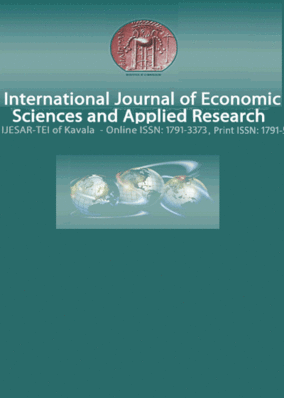The impact of exchange rate changes on disaggregated agricultural output in Nigeria : a two-stage-least-squares approach
Part of : International Journal of Business and Economic Sciences Applied Research ; Vol.6, No.1, 2013, pages 75-89
Issue:
Pages:
75-89
Author:
Abstract:
Agriculture was the mainstay of the Nigerian economy prior to independence and immediately after. Agriculture however, has suffered persistent decline since the 1970s with the exchange rate policy being implicated in the misfortune of this sector. Earlier studies on the effect of exchange rate on agricultural output focussed on aggregate output and ignored the possibility of differences in the response of components of agricultural output. Besides, the fact that there may be a possibility of reverse causality between the exchange rate and agricultural output has been ignored in earlier studies. This study attempts to fill these gaps, by investigating the effect of the exchange rate change s on the components of agricultural output using the two-stage- least-squares techniques for the period between 1970 and 2008. The obtained result indicates that there are differences in the way the output of different sub-sectors responds to the exchange rate changes. While the exchange rate changes have negative effects on crop and fishery output, they have positive effects on livestock and forestry. The fact that the real exchange rate has differential effect on the output of the agricultural sub-sectors indicates the need for policy to be put in place to mitigate the adverse consequences of the exchange rate depreciation on crop and fishery output.
Subject (LC):
Keywords:
exchange rate, disaggregated, agricultural output and two-stage-least-squares
Notes:
Περιέχει διαγράμματα, πίνακες και βιβλιογραφία, JEL Classification: Q17, 013, F31
References (1):
- Adebiyi, M.A., 2009, ‘Inflation Targeting: Can we Establish a stable and PredictableRelationship Between Inflation and Monetary Policy Instruments in Nigeria andGhana?’, Applied Econometrics and Macroeconometric Modelling in Nigeria, edsAdenikinju, A., D. Busari and S. Olofin, University of Ibadan Press, pp. 211-239.Adewuyi, A.O., 2005, ‘Trade and Exchange Rate Policies and Economic Performance inNigeria: An Empirical Analysis’, The Nigerian Journal of Economic and Social Studies,47, 2, pp. 249-280.Adragi, B. and M. and Allender, 1998, ‘Budget deficits and stock prices: Internationalevidence’, Journal of Economics, 22, 2-3, pp. 57-66.Agenor Pierrer-Richard, 1991, Output, Devaluation and the Real Exchange Rate inDeveloping Coutries’, Weltwirtschaftliches Archive, Band 127.Bahmani-Oskooee, M., 1998, ‘Are Devaluations Contractionary in LDCs?’, Journal ofEconomic Development, 23, 1, pp. 131-144.Berument H. and M. Pasaogullari, 2003, “Effects of the real exchange rate on output andinflation: Evidence from Turkey’, The Developing Economies, 41, 4, pp. 401-435.Central Bank of Nigeria, 2008, Statistical Bulletin, 18, Abuja, Nigeria.Cooper R.N., 1971, ‘Currency Devaluation in Developing Countries’, Essays inInternational Finance, 86, International Finance Section, Princeton University.Diaz-Alejandro, C.F., 1963, ‘Notes on the Impact of Devaluation and Redistributive Effect ’,Journal of Political Economy, 71, pp. 577-580.Domac, I., 1977, ‘Are devaluations contractionary? Evidence from Turkey’, Journal ofEconomic Development, 22, 2, pp. 145-163.Edwards, S., 1989, Real Exchange Rates, Devaluation and Adjustment : Exchange RatePolicy in Developing Countries, Cambridge, Mass.: MIT Press.Gujarati, D.N., 2005, Basic Econometrics, fifth Edition, McGraw-Hill, Inc,Judge, G.G., W.E. Griffiths, R.C. Hill, H. Lutkepohl and T.C. Lee, 1985, The Theory andPractice of Econometrics, Second Edition, New York: John Wiley.Kamin S.B. and J.H. Rogers, 2000, Output and the real exchange rate in developingcountries: an application to Mexico’, Journal of Development Economics, 61, pp. 85-109.Kandil M. and I. A. Mirzaie, 2003, ‘The Effects of Exchange Rate Fluctuations on Outputand Prices: Evidence from Developing Countries ’, IMF Working Paper, WP/03/200.Maddala, G.S., 1988, Introduction to Econometrics, Second Edition, Macmillan PublishingCompany, New York.Odusola A.F. and A.E. Akinlo, 2001, Output, Inflation and Exchange rate in Developingcountries: Application to Nigeria ’, The Developing Economies, XXXIX, 2, pp. 199-222.Ogun, Oluremi, 2000, ‘Real Exchange Rate Behaviour and Non-oil Export Growth inNigeria’, African Journal of Economic Policy (AJEP), 11,1, pp. 69-90.Oyejide T.A and Ogun, O., 1995, ‘Structural Adjustment and Exchange Rate Policy’ inA.Iwayemi (Ed.), Macroeconomic Policy Issues in an Open Developing Economy: Acase Study of Nigeria, (National Centre for Economic Management and Administration,NCEMA, Ibadan, Nigeria), pp. 307-327.Palm, F., 1983, ‘Structural Econoetric Modelling and Time Series Analysis’, Applied TimeSeries Analysis of Economic Data, Economic Research Report ER-5, ed Arnold Zellner,US Department of Commerce, Washington DC, 199-233.Tutar, E., 2002, Inflation Targeting in Developing countries and its applicability to theTurkish Economy, M. Sc. Dissertation, Faculty of the Virginia Polytechnic Institute andState University.Ubok-Udom, E.U., 1999, ‘Currency depreciation and domestic output growth in Nigeria,1971-1995 ’, The Nigerian Journal of Economic and Social Studies, 41,1, pp. 31-44.WD1 CD ROM, 2008, World Development Indicators, Published by the World Bank.Yaqub, J.O., 2010, ‘Exchange Rate Changes and Output Performance in Nigeria: A SectorialAnalysis ’, Pakistan Journal of Social Sciences, 7, 5, pp. 380-387.




